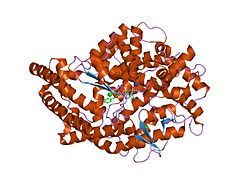Angiotensin converting enzyme
| Angiotensin converting enzyme | ||
|---|---|---|

|
||
| Representation of the ACE according to PDB 1O86 | ||
|
Existing structure data: 1O86 , 1O8A , 1UZE , 1UZF , 2C6F , 2C6N , 2IUL , 2IUX , 2OC2 , 2XY9 , 2XYD , 2YDM , 3BKK , 3BKL , 3L3N , 3NXQ , 4Aph , 4APJ , 4BXK , 4BZR , 4BZS , 4C2N , 4C2O , 4C2P , 4C2Q , 4C2R , 4CA5 , 4CA6 |
||
| Properties of human protein | ||
| Mass / length primary structure | 1277 and 1203 amino acids, respectively | |
| Secondary to quaternary structure | single pass type I membrane protein | |
| Cofactor | Zn 2+ , Cl - | |
| Isoforms | S1, S2, T | |
| Identifier | ||
| Gene names | ACE ; ACE1; CD143 | |
| External IDs | ||
| Enzyme classification | ||
| EC, category | 3.4.15.1 , metalloprotease | |
| MEROPS | M2 | |
| Substrate | Angiotensin I. | |
| Products | Angiotensin II | |
| Occurrence | ||
| Homology family | HBG018160 | |
| Parent taxon | Jaws | |
| Orthologue | ||
| human | House mouse | |
| Entrez | 1636 | 11421 |
| Ensemble | ENSG00000159640 | ENSMUSG00000020681 |
| UniProt | P12821 | P09470 |
| Refseq (mRNA) | NM_000789 | NM_001281819 |
| Refseq (protein) | NP_000780 | NP_001268748 |
| Gene locus | Chr 17: 63.48 - 63.5 Mb | Chr 11: 105.97 - 105.99 Mb |
| PubMed search | 1636 |
11421
|
Angiotensin converting enzyme ( engl. Angiotensin Converting Enzyme , short ACE ) (synonym kininase II ) is an enzyme that in the maintenance of blood pressure of the control and the water-electrolyte balance is of great importance.
One isoform , alpha-ACE, occurs primarily on the surface of the endothelial cells of the pulmonary vessels. Beta and gamma ACE are found in the endothelia of the renal vessels. ACE could also be detected in fibroblasts , monocytes , macrophages , sperm and nerve cells .
ACE has the properties of a peptidase and converts the peptide and prohormone angiotensin I into the hormone angiotensin II by splitting off the two C-terminal amino acids within the renin-angiotensin-aldosterone system . This has a strong vasoconstrictor effect ( vasoconstrictor ). In this way, ACE indirectly increases blood pressure. ACE also supports this function by splitting off the two C-terminal amino acids of the tissue hormone bradykinin , which leads to its inactivation.
Medical importance
ACE inhibitors are used to treat arterial hypertension and heart failure . With a turnover of around 1.9 billion EUR / year (2008), they form the pharmaceutical group with the highest turnover in Germany.
Elevated levels of ACE can be an indication of sarcoid .